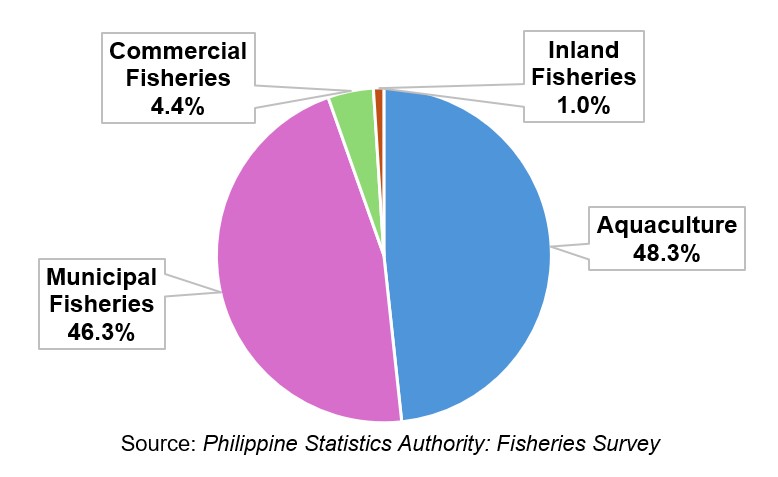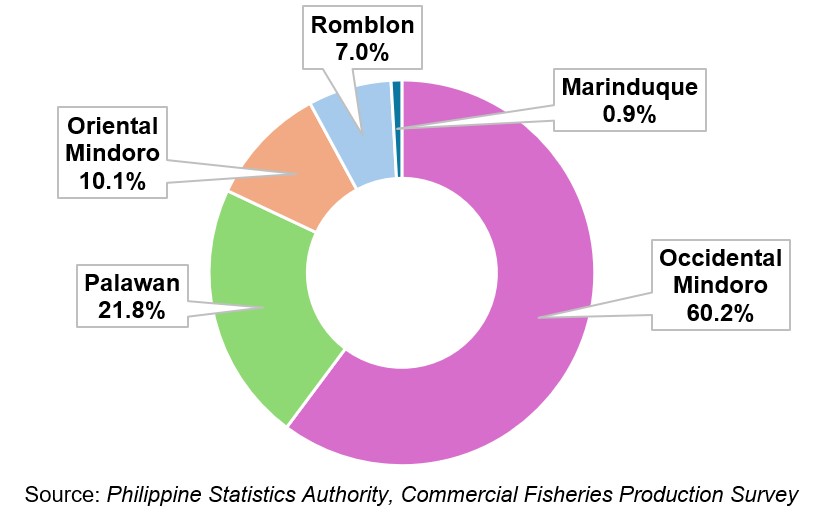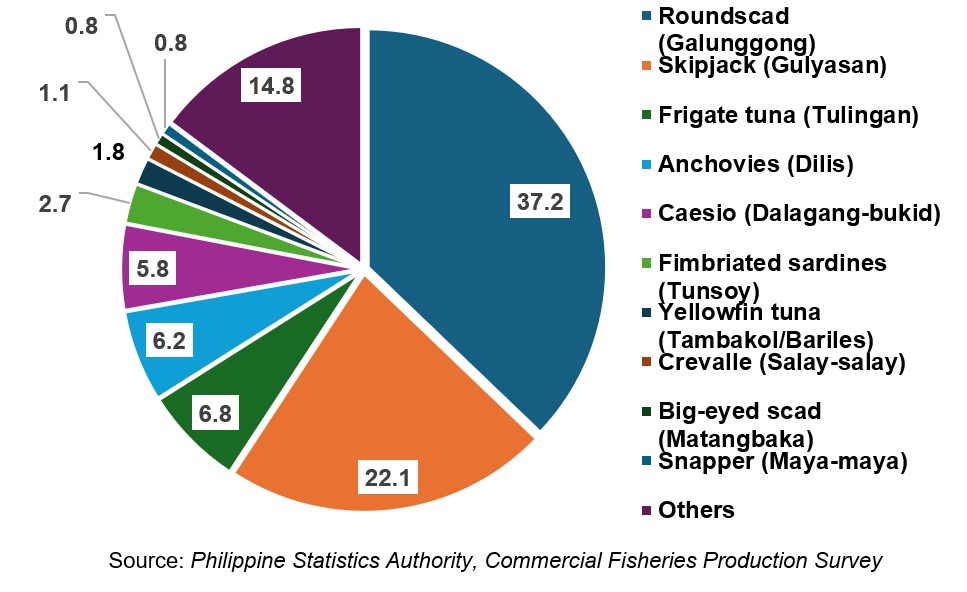Commercial fisheries production contributed 4.4 percent
The total fisheries production in the MIMAROPA Region in the first quarter of 2023 was reported at 85,244.75 metric tons. This indicates an increase of 29.1 percent from 66,030.88 metric tons of output in the first quarter of 2022. The volume of commercial fisheries production contributed 4.4 percent to the total fisheries production in this quarter. Based on the Quarterly Commercial Fisheries Production (QCFS), commercial fisheries production was registered at 3,742.37 metric tons, which translated to a decline of 31.5 percent from 5,465.76 metric tons production in 2022 (Figure 1) (Tables 1 and 2).
Figure 1. Percentage Distribution of Volume of Fisheries Production by Subsector
January - March 2023

Highest production observed in Occidental Mindoro
Among the provinces in the region, Occidental Mindoro had the highest catch with 2,252.22 metric tons, which increased by 22.7 percent from 1,836.25 metric tons in 2022. It contributed more than half (60.2%) of the total production of commercial fisheries. Followed by Palawan with the production of 814.88 metric tons. Despite the 73.8 percent decrease in production from 3,108.21 metric tons last year, it was second to the highest contributor by 22 percent.
Meanwhile, Oriental Mindoro, with a 10.1 percent share, has the third highest production of 378.00 metric tons. It has the highest growth rate of 97.7 percent. The production of the province of Romblon was reported at 263.65 metric tons, which decreased by 3.5 percent from the 273.23 metric tons output in 2022. It contributed 7.0 percent of the total fisheries production (Table 2) (Figures 2 and 3).
Lowest production observed in Marinduque
The lowest production of commercial fisheries was observed in Marinduque with 33.62 metric tons, which decreased by 40.9 percent from 56.85 metric tons in the same quarter last year. It contributed 0.9 percent of the total production (Table 2) (Figures 2 and 3).
Figure 2. Volume of Commercial Fisheries Production by Province:
January - March 2023 and January - March 2022

Figure 3. Percentage Distribution of Volume of Production by Province:
January - March 2023

Top 10 Leading Species in Commercial Fisheries
Among all the species in Commercial fisheries, the top 10 leading species were selected which have the largest volume production during this quarter.
Roundscad had the highest production in this quarter with 1,391.93 metric tons; this also increased production by 80.9 percent from 769.33 metric tons of output in 2022. This was followed by Skipjack, its production registered at 827.42 metric tons, which had the largest increase of 527.0 percent from 131.96 metric tons compared to 131.96 metric tons output last year. Frigate tuna came in third in terms of production, with the highest catch of 253.83 metric tons; however, its production declined by 65.4 percent from 733.59 metric tons last year. Followed by Anchovies with 230.77 metric tons; Caesio with 216.85 metric tons; Fimbriated sardine with 102.78 metric tons; Yellowfin tuna with 67.12 metric tons; Crevalle with 39.47 metric tons; Big-eyed scad with 28.64 metric tons; and Snapper with 28.07 metric tons, which posted a decrease in growth rate except for Crevalle, which increased by 27.6 percent during this quarter (Table 3) (Figure 4).
Figure 4. Volume of Production by Species:
January - March 2023 and January - March 2022

Roundscad was the top species during the first quarter of 2024
Roundscad was the top contributor to the total commercial fisheries production, with a 37.2 percent share. Skipjack followed at 22.1 percent share: Frigate tuna (6.8%); Anchovies (6.2%); Caesio (5.8%); Fimbriated sardines (2.7%); Yellowfin tuna (1.8%); Crevalle (1.1%); Big-eyed scad (0.8%); and Snapper (0.8%). Other species shared 14.8 percent of the total commercial fisheries production during this quarter (Table 3) (Figure 5).
Figure 5. Percentage Distribution of Volume of Production by Species:
January - March 2023

SGD. LENI R. RIOFLORIDO
Regional Director
MLLM / OHG / RVLD / CNB

